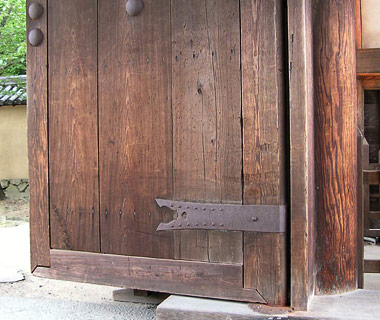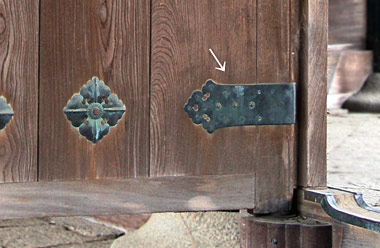Also called hassou kanamono 八双金物; sakawa kanagu 逆輪金具 or saba-no-o
鯖の尾. Lit. twin eights metalwork. A long, narrow decorative metal work fitting
*kazarikanagu 飾金具,
that is bent around the hinged edge of a door leaf in such a way that the forked
design appears on both sides of the door. Generally, the metalwork is gilt bronze
and is nailed down top and bottom near the edges with about one third exposed
on either side of the door. Aside from being decorative, it is practical. It strengthens
the pivot hinge *jikuzuri
軸釣 and prevents separation from the door leaf. The name is derived from the identical
forked design on each side of the door leaf (as sou 双 means 'both), and
the forked part resembling the character 八 hachi, meaning eight. Many hassou
kanagu are decorated with embossed patterns on a thin metal sheet. From the
Momoyama period and into the Edo period, some were made
with brilliant relief patterns on thick metal plates. An example can be found
on the plank doors *itakarado
板唐戸, of the Guest Hall, Kyakuden 客殿 at Daikakuji 大覚寺, in Kyoto. In this
case, the ends are not forked but protrude. Patterns with protruding ends in the
shape of a flower are called dehassou 出八双. These are the standard types
of decorative metal-work on doors. Prior to the Heian period dehassou
were used exclusively and continued to be used even after the introduction of
the popular hassou kanagu in the Kamakura period. The type
of hassou kanagu that attached only around the front stiles and top and
bottom rails of a door as pure ornamentation is called chirashihassou 散八双.
A hassou kanagu in a forked fish-tail inlet is called *irihassou
入八双.
|




